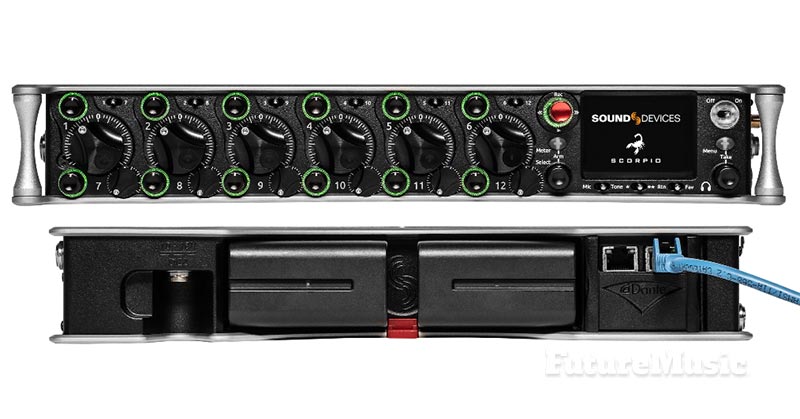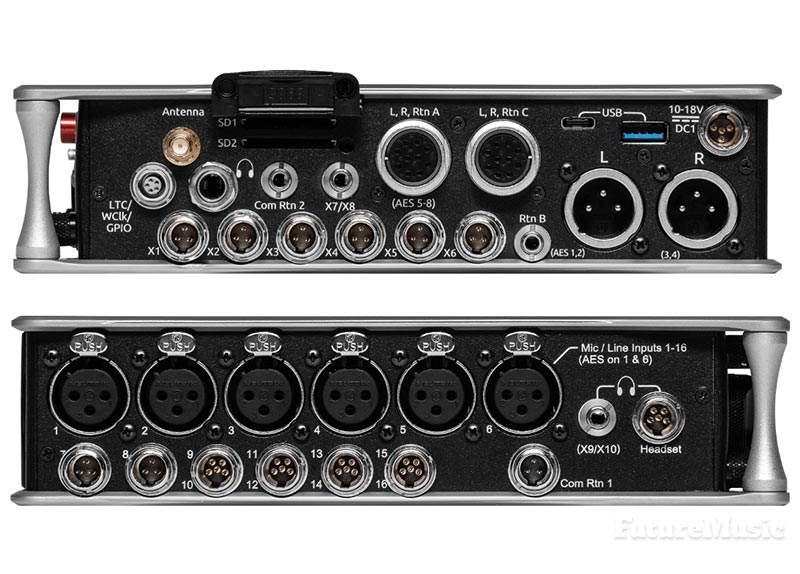Sound Devices has premiered Scorpio, a 32 channel, 36 track portable mixer-recorder. Scorpio is the most powerful product ever designed by Sound Devices, and the ideal tool for the new era of production sound. With 16 mic/line preamplifiers, 32 channels of Dante in and out, AES in and out, 12 analog outputs and multiple headphone outputs, Scorpio is well-suited for any production scenario. A fully-customizable routing matrix enables sound professionals to send any input to any channel, bus, or output. Up to 12 buses may be individually mixed. Due to its compact form factor, the Scorpio is equally at home over-the-shoulder or in a mobile rig.

Scorpio is a 32 channel, 36 track mixer-recorder and the most powerful product ever designed by Sound Devices. With 16 mic/line preamplifiers, 32 channels of Dante in and out, AES in and out, 12 analog outputs and multiple headphone outputs, Scorpio is well-suited for any production scenario. Featuring a fully-customizable routing matrix, ultra-low noise preamplifiers, multiple powering options, a premium-quality build equally useable over-the-shoulder or in a mobile rig, high-powered processing, and an internal 256GB SSD with two SD card slots.
Scorpio incorporates Sound Devices’ most cutting-edge technology. An ultra-powerful engine comprised of three FPGA circuits and six ARM processors deliver the horsepower needed for the most complex tasks. FPGA-based audio processing with 64-bit data paths ensures the highest sound quality and reliability. The Scorpio also features Sound Devices’ latest and best in analog microphone preamplifier design. These preamps have the smoothest sound and lowest noise of any preamp in the company’s 20-year history and include built-in analog limiters, high pass filters, delay, 3-band EQ and phantom power.

Like the company’s popular 788T, the Scorpio has an internal SSD and adds the ability to simultaneously record to two SD cards for redundancy. For additional flexibility, sound professionals can send different files to their choice of media. The companion SD-Remote Android application allows for control of the Scorpio via a large display.
Great attention to detail has been paid to every aspect of the Scorpio’s design. Most common menus are accessible with only one or two button presses, and many menu shortcuts can be achieved with only one hand. Scorpio features a built-in dual L-Mount battery charger and may be powered with L-Mount batteries or via the TA4 DC inputs using smart batteries, NP-1 batteries, or in-line power supplies. The ultra-accurate, fully-featured timecode generator contains its own battery to hold timecode for up to four hours after power off.
Sound Devices’ Scorpio costs $8,995 and can be pre-ordered from Sound Devices authorized resellers with shipping slated for the second quarter of 2019.
Sound Devices
Sound Devices Scorpio Specifications:
» Freq. Response: 10 Hz to 80 kHz ± 0.5 dB (192 kHz sample rate, re 1 kHz)
» THD + Noise • 0.005% max (1 kHz, 22 Hz–22 kHz BW, trim @20, fader @ 0, -10 dBu in)
» Equivalent Input Noise: -131 dBV (-129 dBu) max (A-weighting, 76 dB gain, 150 ohm source impedance)
» Processing Engine:
— Highly extensible, full FPGA-based audio processing, 3 FPGAs
— Six-way ARM multiprocessor system
— 64-bit audio processing precision
» Audio Over Ethernet:
— Dante, 32 channels in, 32 channels out
— AES67 compatible
— 1 Gb/s Ethernet, 2 ports, transformer-balanced
» Inputs:
— Mic/Line inputs: 16 total, all fully featured; 6 on full-size XLR, 2 on TA3, 8 on TA5
— Mic-level inputs: (XLR, TA3, TA5): Class-A, discrete differential long-tail pair, 4k ohm input impedance
— Line-level inputs: (XLR, TA3, TA5): active-balanced, 4k ohm input impedance
— AES3 or AES42 available on XLR inputs 1 and 6
— AES42: +10 V, 250 mA available, type-1, auto-ASRC
— Rtn A, B, C (3.5 mm/10-pin): unbalanced 2-channel, 4k ohm input impedance
— Com Rtn 1,2 (TA3, 3.5mm) balanced, 1-channel, 8k ohm input impedance
— External Slate Mic (TA5): balanced, 8k ohm input impedance, menu-selectable 12 V phantom
» Maximum Input Level:
— Mic: +8 dBu (2.0 Vrms)
— Line: +28 dBu (19.5 Vrms)
— Rtn A, B, C: +18 dBu (6.2 Vrms)
— Com Rtn 1, 2: +24 dBu (12.3 Vrms)
— External Slate Mic: +12 dBu (3.2 Vrms)
» High-Pass Filters: Adjustable 40 Hz to 320 Hz, 18 dB/oct. 1st stage analog (before preamp), 2nd stage digital
» Limiters:
— Limiters available at all channels, buses, headphones, for all sample rates
— Analog first stage, all subsequent stages digital
— Attack time: 1 ms
— Release time: adjustable, 50 ms to 1000 ms
— Threshold: adjustable, -2 dBFS to -12 dBFS
— Selectable knee: hard or soft
— Selectable ratio: inf:1, 20:1
» Delay: Channel Adjustable 0-50 ms | Output Adjustable 0-500 ms
» Maximum Gain: Trim stage (mic input): 76 dB | Trim stage (line input): 36 dB | Fader stage: 16 dB | Bus stage: 16 dB | Headphone stage: 20 dB | Mic-to-Line: 108 dB | Mic-to-Headphone: 112 dB
» Outputs: XLR (L, R) active-balanced, 250/3.2k/120 ohms (mic/-10/line)
— Hirose 10-pin (L, R) active-balanced, 250/3.2k/120 ohms (mic/-10/line)
— TA3 (X1-X6) active-balanced, 250/3.2k/120 ohms (mic/-10/line)
— 3.5mm (X7, X8): unbalanced, stereo, 1.8k ohms
» Headphone Outputs: 1/4″, 3.5 mm | TA5 (along with mic input pins) for single connection to headset + mic | High output, 4 ohm output impedance, 400 mW + 400 mW at each
connector, all individually driven • Compatible with headphones of any impedance
» Maximum Output Level: (all into 10k load) Line: +20 dBu (7.8 Vrms) | “-10″: +6 dBu (1.5 Vrms) | Mic: -20 dBu (0.078 Vrms) | X7/X8 Out: +6 dBu (1.5 Vrms) | Headphone outputs 1/4”, TA-5, (9/X10): +14 dBu (4.0 Vrms)
» A/D converters: 32-bit, 120 dB, A-weighted dynamic range typical | Sampling rates 44.1 kHz, 47.952 kHz, 48 kHz, 48.048 kHz, 88.2 kHz, 96 kHz, 192 kHz
» Digital Outputs: AES3 transformer-balanced, in pairs; 1-2 (XLR-L), 3-4 (XLR-R), 5-8 (Hirose 10-pin A) | 110 ohm, 2 V p-p, AES and S/PDIF compatible
» Recording:
— Internal 256 GB SSD
— Two removable SD Cards
— Simultaneous recording to internal SSD and the two SD cards
— exFAT formatting
— 36 tracks (32 iso channels, 4 buses)
— Broadcast WAV monophonic and polyphonic file format
— 64-bit WAV (RF64) monophonic and polyphonic; support for files > 4 GB
» USB: USB-C (USB 3.1 type 1) for file transfer of internal SSD, both SD Cards | USB-A host for keyboard, external controller, external USB hubs supported for connecting multiple devices Wireless | Built-in Bluetooth v5.0 BLE (not supported with rev 1.0 release of SD-Remote)
» Timecode and Sync:
— Modes Supported: Off, Rec Run, Free Run, 24h Run, External, including External Auto-Record and Continuous modes. • Frame Rates: 23.98, 24, 25, 29.97 DF, 29.97 ND, 30 DF, 30 ND • Sample/Timecode Accuracy: 0.1 ppm (0.25 frames per 24 hours)
— Timecode Input: 20k ohm impedance, 0.3 V – 3.0 V p-p (–17 dBu – +3 dBu)
— Timecode Output: 75 ohm impedance, 5 V p-p (+12 dBu)
— Word Clock Input: 10k/75 ohm selectable impedance, 1-5 V p-p input sensitivity
— Word Clock Output: 75 ohm impedance, 5 V p-p output, at SR
» Remote Control: USB MIDI Control – 3rd party fader controllers | SD-Remote Android app | USB Keyboard | External Timecode Record Trigger
» LCD: 320×240, Transflective, excellent sunlight visibility | Larger touchscreen display available via USB-connected SD-Remote app
» Power:
— External: dual 10-18 V inputs on locking TA4 connectors, pin-4 = (+), pin-1 = (-)
— Dual rear-mount Sony-style L-mount batteries with chargers
— Idle Current Draw: 875 mA @ 12 V (10.5 W)
— Intelligent power-down of unused mic preamps and other internal circuits
» Environmental: Operating: -20° C to 60° C, 0 to 90% relative humidity (non-condensing) | Storage: -40° C to 85° C
» Dimensions: (H x W x D) 5.1 cm x 32 cm x 20.5 cm ( 2 in x 12.6 in x 8.1 in)
» Weight: 5.8 lbs (2.63 kg) unpackaged, without batteries








